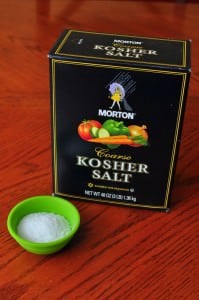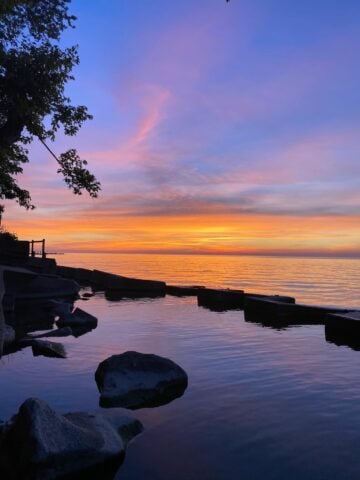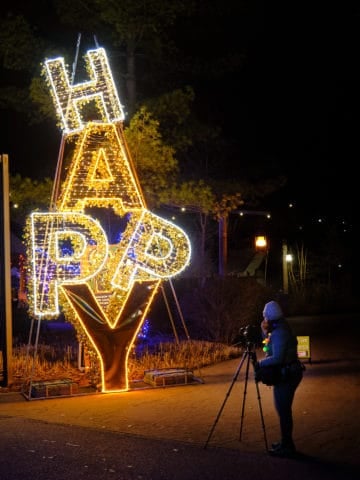
I keep running into a roadblock with my recipes. Salting is the key element to seasoning food, and I don't know how much salt to tell people to use.
I use Diamond Crystal Kosher salt because I salt by hand. The big crystals of Kosher salt are easy to grab and sprinkle, unlike table salt, which has such tiny crystals that I can't get hold of it. I know that a two finger pinch of Diamond Crystal Kosher gives me a half teaspoon of salt. (Yes, I measured.) I've been using it for a while, and I have a good feel for how it works.
But when someone takes that into their own kitchen, with their own fingers and a different brand of salt, what does it mean?
With salt, density matters*. I've read that Diamond Crystal Kosher salt, with its large flakes, weighs half as much by volume as table salt, with its tiny grains. In other words, a half cup of table salt packs in as much salt as a whole cup of Diamond Crystal. (Morton's Kosher supposedly weighs in between the two, at ¾ cup).
*Salt...it is your density.
I should take this information at face value. It's from Cooks Illustrated, so I'm sure they did their research. But I am borderline obsessive-compulsive thorough. I decided to measure all the different types of salt I use, from ultra-fine grained pickling salt to Maldon sea salt with its huge flakes.
Conversion Chart

To convert from one salt to another: The row is the salt the recipe calls for, and the column is the salt you want. Find the row for the recipe's salt, then move to the right until you get to the column of the salt you have, and multiply the amount in the recipe by that number. (Then I cheat a little, and round to the nearest number that matches my measuring spoons.)
Example 1: A recipe calls for 1 tablespoon of Diamond Crystal Kosher Salt, and you have Mortons Kosher salt. Find the Diamond Crystal row, go across until you get to the Mortons Kosher column, 0.7. The multiplication is easy: you want 1 x 0.7 = 0.7 tablespoons. (Since I know a tablespoon is 3 teaspoons, and 3*0.7 = 2.1 teaspoons, I round down a little and use 2 teaspoons of Mortons.)
Example 2: A recipe calls for 1 teaspoon table salt, and you have RealSalt fine sea salt. Find the Mortons table salt row (1st row), then go across until you get the RealSalt fine sea salt column, 1.2. You need 1.2 teaspoons of fine sea salt. (And I would round up to 1.25 teaspoons to make for easy measuring).
Data
Here are the raw numbers:
| Salt Type | Weight of ¼ cup (grams) | Weight of ¼ cup (ounces) | Replacement Percent Diamond Crystal Kosher |
|---|---|---|---|
| Morton’s Table Salt | 76.0 | 2.68 | 59% |
| Morton Pickling Salt | 74.0 | 2.61 | 61% |
| La Baleine Coarse Sea Salt | 66.8 | 2.36 | 68% |
| Real Salt Fine Sea Salt | 65.0 | 2.29 | 70% |
| La Baleine Fine Sea Salt | 64.8 | 2.29 | 70% |
| Real Salt Kosher Salt | 64.0 | 2.26 | 71% |
| Morton’s Kosher Salt | 62.0 | 2.19 | 73% |
| Diamond Crystal Kosher Salt | 45.2 | 1.59 | 100% |
| Maldon Sea Salt | 33.2 | 1.17 | 136% |
What did I learn from this?
- Cooks Illustrated was right. A half cup of table salt equals ¾ cup of Mortons Kosher equals 1 cup of Diamond Crystal. Roughly - it slightly over weights table salt and under weights Morton's Kosher, but it's close enough.
- Fine sea salt is not a 1:1 replacement for table salt. I buy fine sea salt from the bulk bin at my local health food store at $0.69/lb, and use it as table salt in my baking recipes. I assumed fine sea salt has the same crystal size as table salt. Oops. Turns out, fine sea salt is closer by weight to Morton's Kosher than it is to table salt. Sea salt must have a crystal with more air in it than table salt. If you'll excuse me, I have to go fix a few of the recipes in my archives…
- Fine sea salt and coarse sea salt have the same density: I assumed coarse sea salt would be lighter than fine sea salt. Nope, wrong again. They are basically identical; in my tests they were within a couple grams of each other, with the coarse sea salt weighing a tiny bit more than the fine sea salt.
- Morton's Kosher salt is not quite weight specific. I read that Morton's Kosher was designed so that its weight would match water, for use in sausage making. Since a pint (of water) is a pound the world around, a pint of Morton's Kosher should also be a pound. Close, but not quite. By my measurements, two cups of Morton's Kosher weigh one pound, one and a half ounces.
- Pickling salt has the same weight as table salt: I expected pickling salt to be heavier than table salt; I heard it had even smaller grains, to help it dissolve faster. It turns out the two are almost exactly the same weight. Table salt is ever so slightly heavier. So, why use pickling salt when pickling? Table salt has added ingredients to keep the salt pourable in humid environments. (Like the ad says, "When it rains, it pours.") Those extra ingredients make pickle brines cloudy. Other than that, pickling salt and table salt are the same thing.
Oh, and the Maldon salt? It is amazing. The flakes are huge and airy. It is a great finishing salt, sprinkled on just before serving. It adds a hit of salty crunch without over-salting the food. Don't use it any sooner in cooking, though, or it will dissolve. There is no difference between dissolved Maldon, Kosher, or table salt - they're just salt at that point. Maldon is very expensive to be "just salt".

What do you think? Questions? Other ideas? Leave them in the comments section below.
Related Posts:
Ingredient questions that I get asked a lot:
A Stalk of Celery vs a Rib of Celery?
Onion Size, or How Big is a Large Onion?
What does Season To Taste mean, exactly?
Things I Love: Diamond Crystal Kosher Salt
*Enjoyed this post? Want to help out DadCooksDinner? Subscribe using your RSS reader or by Email, recommend DadCooksDinner to your friends, or buy something from Amazon.com through the links on this site. Thank you!










Ricka G
Thank you for this! I couldn't figure out why my whole wheat bread tasted like it needed salt. Like you, I thought that sea salt weighs the same as table salt.
Mike Vrobel
You're welcome!
Nancy
This is very helpful. I appreciate that you listed the exact weights and percentages, as I often change the recipe to reflect the amount of kosher salt. Sometimes I use sea salt in a recipe, so I was surprised to see that the weights of sea salt and table salt are not equal. Good to know. Thanks Mike!
jim smith
Great info-Thank you much!!!!!!!!!
chris
This is great stuff, especially for those of us who use the equilibrium brine method in which weight of salt is critical.
Sunny
Bless you kind sir! This is exactly what I needed. Husband had trouble finding Diamond kosher salt (though he remembered it was what I prefer) so got Morton, I know weighing ingredients is better than measuring spoons/cups, so I wanted to find the weight of a 1/2 cup of Diamond kosher salt to match for a pickle recipe. Thank you thank you!
Tom H
And that's another reason why measuring ingredients by weight is the way to go when it matters...!
Tim
Great post -- thanks for the legwork, especially the grams! I'm normalizing my bread recipes to baker's percentages, and metric is oh so much easier.
A couple comments:
-- Weight of water. In the metric system, water has a density of 1.0 @ 0C (it does vary with temperature) and we roughly use 30 grams as one fluid ounce for water, whereas an ounce (wt) is 28.35 grams. Rose Levy Birenbaum quotes water as 8.3 ounces (236.35 gr) per cup at room temperature, and she has probably tested this.
-- Table salt also is typically idodized through the addition of sodium iodide (so it's a boost in sodium, too) as well as the anti-caking ingredients to make it pour when it rains.
Mike V @ DadCooksDinner
Thanks, Helen! My video goes up Thursday...not as good as yours, but I'm hoping to get closer with some of those tips you gave in your post.
(For anyone reading these comments: Helen writes the Beyond Salmon blog BeyondSalmon.com. She wrote a great post on cooking videos today. Check it out at http://www.beyondsalmon.com/2012/03/how-to-make-cooking-videos.html)
Helen Rennie
Hi there Mike!
I saw your comment about videos and came to check it out. I guess it's not posted yet, but I loved your post on salt. I am currently working on yet another salt post. For a whole week, I was weighing salt when seasoning my proteins and wondering if anyone besides me really cares what percent of salt by weight is ideal. I am so glad I found a kindred spirit 🙂
Can't wait to see your videos!
Cheers,
-Helen
Mike V @ DadCooksDinner
I'd like to say I've gone to weights - but I only do it when I'm baking. Other than that, I salt by hand, or when I'm wet brining I use volume.
I know, I know, shame on me...but one of the reasons I cook instead of bake is because I'm a "pinch of this, dash of that" kind of cook. Close enough is good enough for me...which doesn't work so well when I'm baking.
Mike V @ DadCooksDinner
Oh, that salted chocolate tart looks so good....
guitarzantx
Excellent information! Thanks for taking the time to do the measurements. I have definitely moved to the methodology of weighing ingredients (as opposed to measuring by volume,) especially when recording my own recipes or adaptations.
Dave_in_TN
I have been weighing pickling salt for brining for a while, so glad to see I am not the only certifiable salt nut on earth!
Mike is right on the weight of water but then again this is a cooking blog, not NASA trying to land on Mars! "A pints a pound the world around" is close enough for me.
Mike V @ DadCooksDinner
You're welcome...and, especially when it comes to soup, you HAVE to salt to taste!
Heidi Younggrasshopper
This is a great post, I always feel like I'm doing a disservice when I say salt to taste.... but it's HARD to not say that. I may do a link or two to your great post, thanks again <3